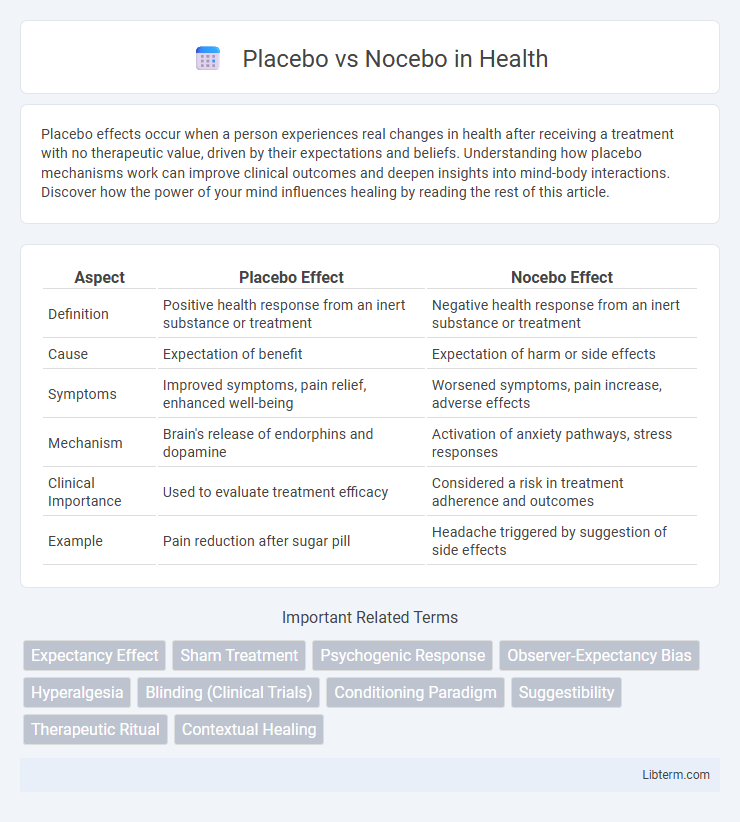Placebo effects occur when a person experiences real changes in health after receiving a treatment with no therapeutic value, driven by their expectations and beliefs. Understanding how placebo mechanisms work can improve clinical outcomes and deepen insights into mind-body interactions. Discover how the power of your mind influences healing by reading the rest of this article.
Table of Comparison
| Aspect | Placebo Effect | Nocebo Effect |
|---|---|---|
| Definition | Positive health response from an inert substance or treatment | Negative health response from an inert substance or treatment |
| Cause | Expectation of benefit | Expectation of harm or side effects |
| Symptoms | Improved symptoms, pain relief, enhanced well-being | Worsened symptoms, pain increase, adverse effects |
| Mechanism | Brain's release of endorphins and dopamine | Activation of anxiety pathways, stress responses |
| Clinical Importance | Used to evaluate treatment efficacy | Considered a risk in treatment adherence and outcomes |
| Example | Pain reduction after sugar pill | Headache triggered by suggestion of side effects |
Understanding the Placebo Effect
The placebo effect occurs when a patient experiences real improvements in symptoms after receiving an inert treatment, driven by expectations of healing and brain chemistry changes. Neuroimaging studies reveal that placebo responses activate brain regions involved in pain relief, such as the prefrontal cortex and the release of endogenous opioids. Understanding the placebo effect enhances clinical trial design and patient care by leveraging psychological and physiological mechanisms to optimize therapeutic outcomes.
The Nocebo Phenomenon Explained
The nocebo phenomenon occurs when negative expectations or beliefs about a treatment cause harmful side effects or worsen symptoms, despite the treatment having no pharmacological effect. This response is driven by the brain's anticipation of adverse outcomes, activating stress and anxiety pathways that can amplify pain or discomfort. Understanding nocebo effects is crucial for clinicians to improve patient care by minimizing negative expectations and enhancing therapeutic outcomes.
Key Differences Between Placebo and Nocebo
Placebo effects occur when an inert treatment induces positive health outcomes due to patients' expectations, whereas nocebo effects result in negative symptoms or side effects triggered by negative expectations. The key difference lies in the psychological mechanisms: placebos enhance perceived well-being through belief and anticipation of benefit, while nocebos exacerbate or create symptoms through fear or anxiety about potential harm. Clinically, understanding these effects is critical for optimizing therapeutic outcomes and minimizing adverse reactions in patient care.
Psychological Mechanisms Behind Placebo and Nocebo
The psychological mechanisms behind placebo and nocebo effects involve complex brain processes such as expectation, conditioning, and emotional regulation, where positive expectations can activate reward pathways reducing symptoms, while negative expectations trigger anxiety and pain-related neural circuits. Neurotransmitters like dopamine and endorphins are released during placebo responses, contributing to symptom relief, whereas nocebo effects often engage stress-related systems including cholecystokinin, exacerbating symptoms. These effects illustrate the powerful role of cognitive and emotional factors in moderating physiological outcomes through mind-body interactions.
Role of Expectation in Placebo and Nocebo Responses
Expectation plays a critical role in both placebo and nocebo responses, where positive expectations can trigger beneficial physiological effects and symptom relief, while negative expectations can provoke adverse side effects even without an active treatment. Neuroimaging studies reveal that expectation modulates brain regions such as the prefrontal cortex and anterior cingulate cortex, influencing pain perception and emotional processing. Understanding this mechanism is essential for optimizing clinical outcomes and minimizing harmful side effects through patient-provider communication and psychological interventions.
Clinical Implications of Placebo and Nocebo Effects
Placebo and nocebo effects significantly impact clinical trial outcomes and therapeutic interventions by influencing patient perceptions and responses to treatment independent of active ingredients. Placebo effects can enhance treatment efficacy through positive expectations, while nocebo effects may induce adverse symptoms or reduce treatment adherence due to negative expectations. Understanding these phenomena is crucial for optimizing informed consent processes, improving patient-clinician communication, and designing clinical trials with appropriate controls to minimize bias and maximize therapeutic benefits.
Real-world Examples of Placebo and Nocebo
Clinical trials reveal placebo effects in pain relief, where patients experience real symptom reduction after receiving inert treatments like sugar pills. Nocebo responses emerge in medication side effect reports, exemplified by patients experiencing adverse effects solely due to negative expectations, such as nausea from harmless capsules. These phenomena highlight the brain's power to influence physical health outcomes through perception and belief.
Impact on Medical Research and Clinical Trials
The placebo effect significantly influences medical research by demonstrating how patient expectations can lead to real physiological changes, thereby complicating the assessment of new treatments. The nocebo effect introduces challenges in clinical trials as negative expectations can cause adverse side effects unrelated to the active drug, potentially skewing safety and efficacy data. Understanding and controlling for both effects is crucial for designing rigorous studies and improving the accuracy of trial outcomes.
Ethical Considerations in Placebo and Nocebo Use
Ethical considerations in placebo and nocebo use revolve around informed consent, patient autonomy, and risk-benefit balance, ensuring patients are aware of potential psychological and physiological effects without deception. Medical professionals must weigh the therapeutic advantages of placebo effects against the harm induced by nocebo responses, avoiding manipulation or withholding of necessary treatment. Transparent communication and adherence to ethical guidelines are essential to maintain trust and uphold the integrity of clinical practice and research.
Strategies to Minimize Nocebo and Maximize Placebo Benefits
Implement clear and positive communication to minimize nocebo effects by framing information with reassuring language and emphasizing treatment benefits. Utilize patient education to enhance understanding, reduce anxiety, and foster positive expectations that boost placebo responses. Tailor interventions with empathy and transparency to build trust, thereby maximizing placebo efficacy while mitigating negative perceptions associated with nocebo.
Placebo Infographic

 libterm.com
libterm.com